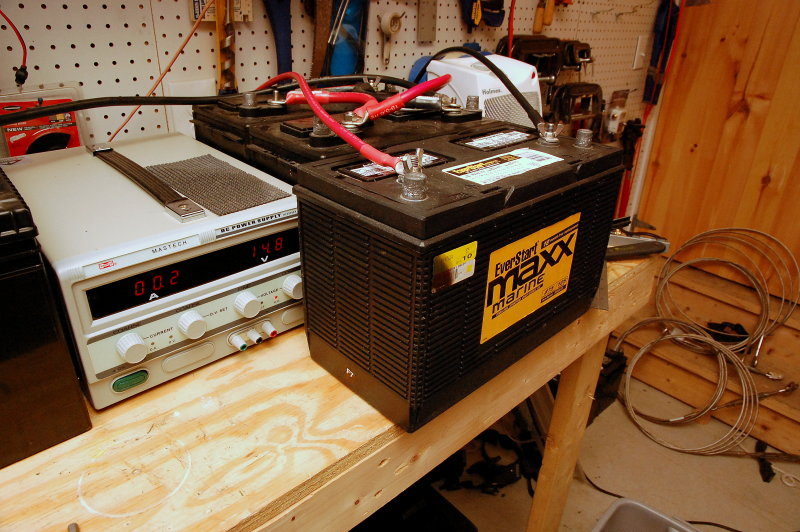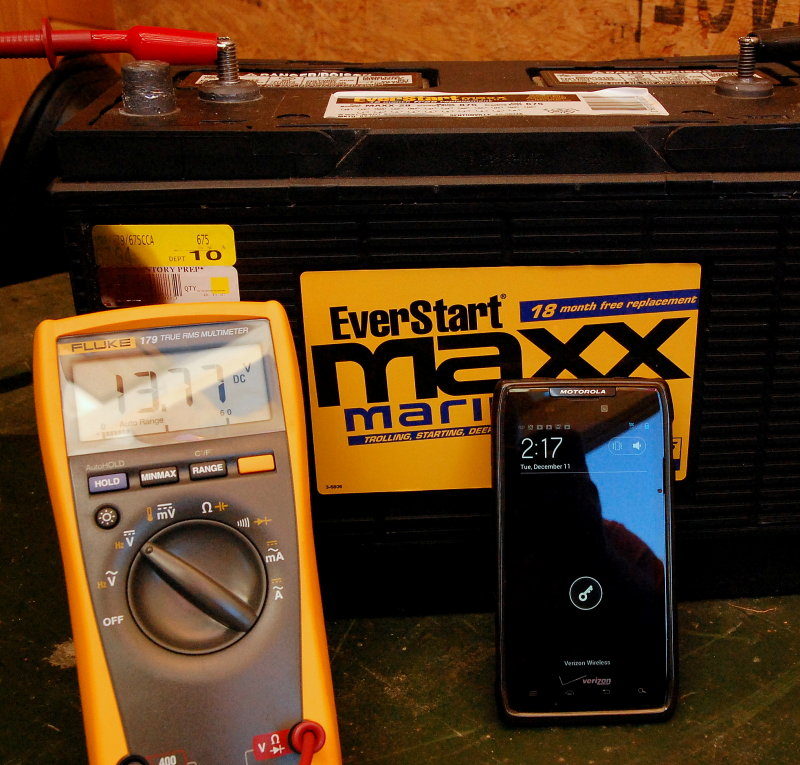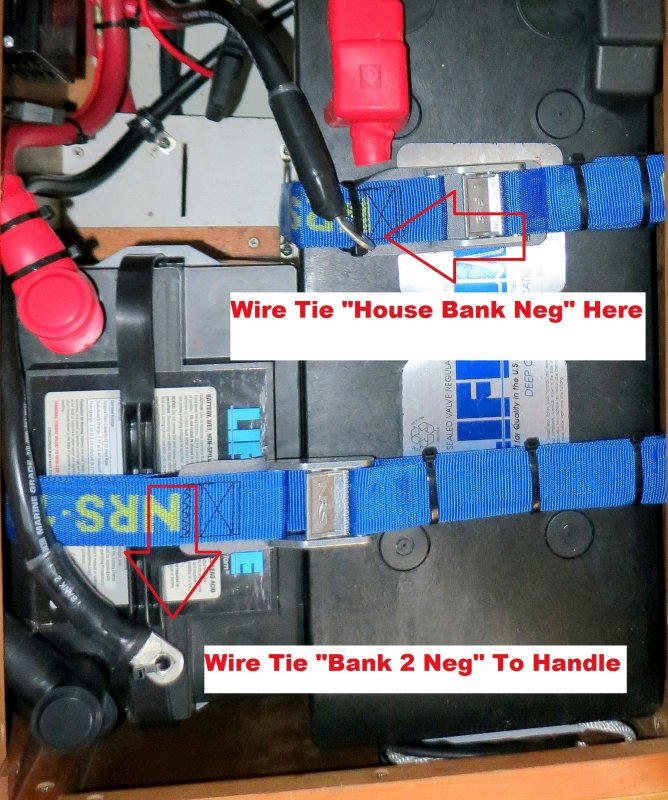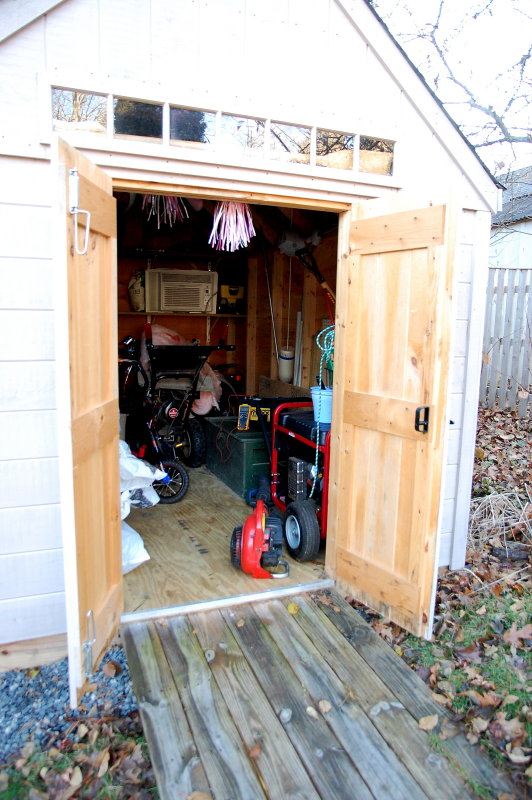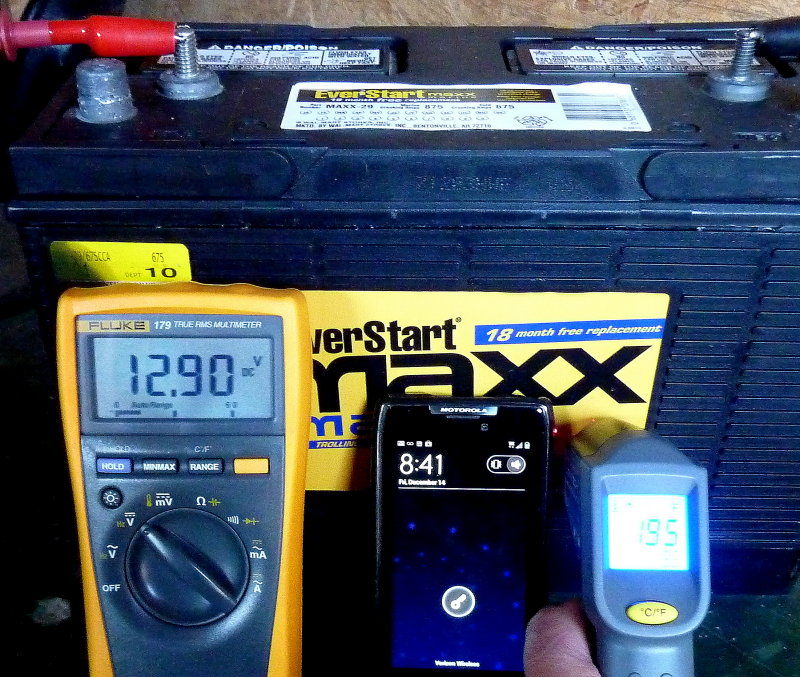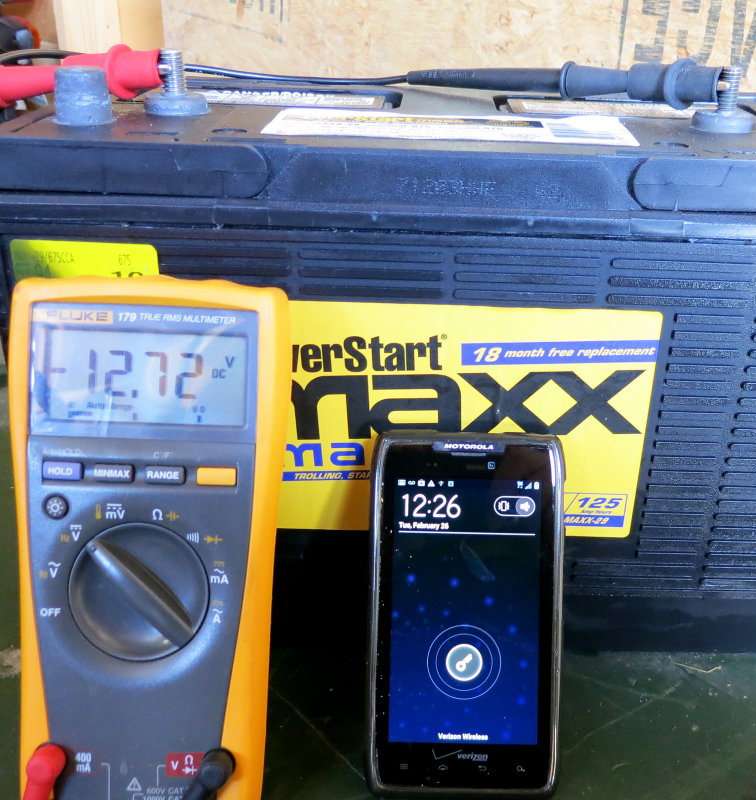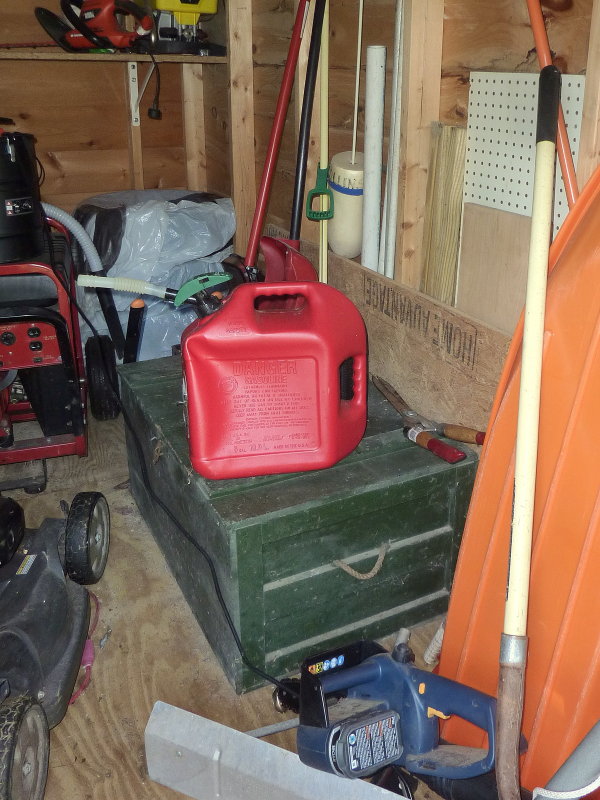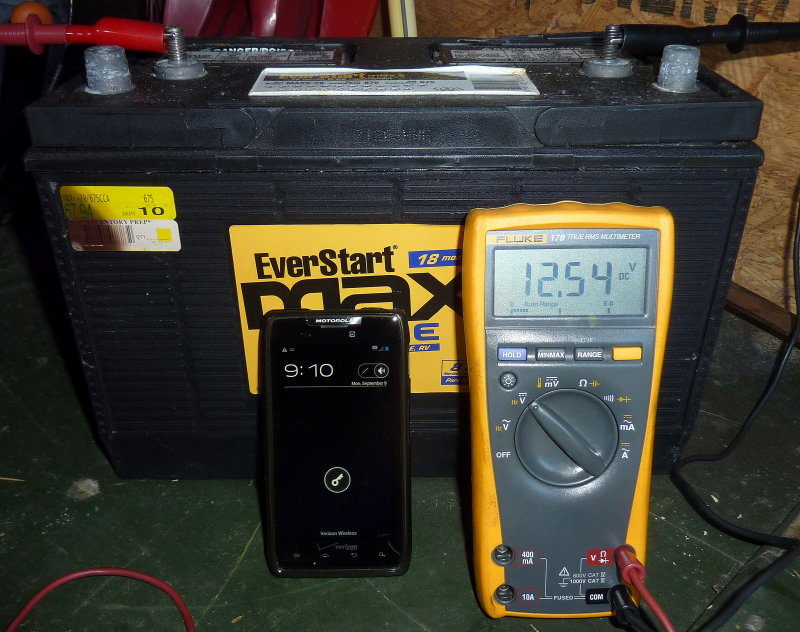December 11, 2012
After having a discussion with one of my customers, about leaving his battery charger running on-board all winter, a practice I am certainly not a huge fan of, and one his boat yard specifically prohibits, I decided to venture into this article.
On December 11, 2012 I charged this used Group 31 used house battery using my bench-top DC power supply. In the shop here we don’t use traditional smart battery chargers and instead we use lab-type variable DC power supplies with independent voltage and amperage control. For shop use I find they are more flexible, extremely accurate and they don’t drop to float prematurely.
Preparing a Battery For Winter Storage:
In order to prep this battery for winter storage, I first charged the battery to an absorption voltage of 14.8V. I then held that voltage and allowed the current to taper down to approx 0.3A, while maintaining the 14.8V absorption voltage. By monitoring the absorption voltage, as well as the net current flowing into the battery, we can use the tail current amperage to tell use when a battery is actually full. To use tail current as an indication of 100% SOC you want to meet two criteria:
1- Absorption voltage set to the maximum safe level for your battery (brand and model dependent)
2- *Absorption Voltage is held until the current flowing into the battery drops to less than 0.5% – 1.5% of Ah capacity (eg: 0.5A to 1.5A or less for a 100Ah battery)
*Premature Floatulation – Premature floatulation is a term I coined years ago for battery charging devices that drop to a float level voltage well before the battery is actually full. This is a chronic issue in the world of so called smart chargers. If tied to a dock all week long this is not a huge issue, and battery charger manufacturers count on this, as the duration you have at float, when dockside, will eventually get the battery back to 100% SOC. In a boatyard with an extension cord, while winterizing your vessel, you don’t have the luxury of time on your side to wait for a premature floatulation charger to finish the job.
It is critical however, when charging batteries for winter storage, that you do not confuse the 0.5% in amperage, or less, at FLOAT voltage vs. ABSORPTION voltage. Just because your smart charger has dropped to float DOES NOT MEAN THE BATTERY IS FULL. Charging a lead acid battery to 100% SOC can take many, many hours and even the best AGM batteries can take in excess of 5 1/2 hours, at best, to go from 50% SOC to 100% SOC and this without premature floatulation. If the charger drops to float too early it can literally take days to get the battery back to 100% SOC. Putting a less than 100% SOC battery into winter storage is simply not good for the battery, Sadly, too many so called smart chargers drop to float well before the battery is actually full. It is up to you to ensure the battery reaches 100% SOC before winter storage and this can be measured by absorption voltage and net current. Please do not trust any Ah counter or other battery monitors SOC screen to tell you when you have attained 100% SOC.
“My battery maker says tail current should be 2% of Ah capacity at absorption voltage to determine 100% SOC?”
I am well aware of this, and it makes good sense from the perspective of a large manufacturer not wanting to risk seeing their batteries chronically over-charged. What I can say, based on many years of physically testing marine batteries, is that I’ve yet to test any battery that suggests a 2% tail current, at absorption voltage, that can deliver 100% of its rated capacity. 2% gets close, and is far better than the point most smart chargers get to before dropping to float, but it does not result in being able to extract 100% of the rated Ah capacity. In the end it will have to be your decision as to when, and at what tail current, you deem your battery full enough for winter storage.
Pre-Storage Equalization:
In this image a customers Trojan batteries are getting equalized before winter storage.
If your batteries are capable of being equalized (EQ), and most AGM and GEL batteries *can not be by the typical “marine charger” definition (*exception Lifeline AGM’s), this is an ideal time to do this. Once the battery or bank has attained 100% SOC you can then start an equalizing charge cycle. It’s critical to not start an EQ charge before the battery is already at 100% SOC. An EQ charge should always be temp compensated to a voltage of 15.5V to 16.2V on the battery, based on manufacturer EQ specs. Run an EQ for at least 30 minutes, even if the cells show good matching specific gravity, or as many as 2-4 hours if the specific gravity readings are off.
The equalization process is a controlled, low-current, high-voltage charge that helps to bring all cells to 100% SOC in order to minimize cell to cell imbalances. EQ can also help reconvert any recoverable lead sulfate and can also help to knock some of the dead lead sulfate off the plate surfaces and yield a healthier battery. If you have never done an equalizing charge please research how your battery maker wants it performed.
This particular battery had good specific gravity (SG) balance between the 6 cells so the battery was then equalized at a voltage of 15.5V for a short 30 minute blast. Fall equalization is a standard practice for me when winterizing flooded or Lifeline AGM batteries before winter storage. The first thing I set up on a fall winterization of a vessel is the bench-top power supply. I start charging first so that by the end of the days work the batteries are 100% charged and ready for isolation.
It is critical, before winter storage, to charge your batteries at the maximum allowed absorption voltage until current declines to 0.5% – 1.5% or less or rated Ah capacity. Following that up with short equalization, when applicable, makes the process truly complete.
Placing the Bank Into Winter Storage Mode:
With the charging steps completed your next step is 100% isolation of the bank from the vessel and any batteries they may be in parallel with. This means completely disconnecting the bank from the boat and then removing any parallel connections. Leaving the batteries in parallel or connected to the vessel is an not the best idea. Parasitic loads or a single bad battery can ruin the entire bank. Occasionally a micro-leak in a seperator can cause a very slow self discharge of a battery cell. If this battery is in parallel with the others it will also drag them down.
Winter Storage Process for Lead Acid Batteries:
1- Prior to charging flooded batteries inspect the electrolyte level in each cell. If plates are exposed add just enough distilled water to cover the plates. For most flooded batteries this is approximately 1/8″ below the bottom of where the “fill well” ends inside the battery.
2- Charge the batteries at their maximum safe absorption voltage until current declines to 0.5% – 1.5% of Ah capacity or even less.
3- After charging flooded batteries re-check electrolyte level and top up as necessary.
4- Check the specific gravity (SG) of each cell if possible (not possible for AGM or GEL).
5- If cells show a good SG balance run a short equalizing charge on them, but only after they have been fully charged.
6- If cells SG readings are slightly out of balance, run an EQ cycle until cell SG is equal or the SG stops rising in all cells.
7- Physically disconnect the batteries from the vessel. This is often easiest on the negative posts but on some boats positive is easiest.
8- Physically disconnect any paralleled batteries from one another.
9- Leave batteries on-board, less risk of injury or dropping a battery doing this. Alternatively, if in a warm climate, remove & store in a cool dry location.
10- In the spring, re-test the open circuit voltage of each battery before re-connecting the bank. The batteries should all be within a few mV of each other.
Into The Shed:
Once I was done charging this test battery I carried it out to the garden shed. The shed is unheated and closely mimics the environment of a boat during winter storage here in Maine. I suppose I could have just carried it up the ladder, and into my boat, but no sense in breaking my back, the temps are the same.
At this point I took the first open circuit voltage (OCV) reading, about ten minutes after discontinuing the charge. It read 13.77V and represented a “surface charge” that had not yet dissipated. After a good equalizing charge surface voltage can remain high for a bit.
100% Bank Isolation Is Critical:
This is an image I sent to a customer who wanted to know how to isolate his bank for winter storage. In most cases, with a cleanly wired bank, it is easiest to simply remove the negative leads from each battery on the boat and then wire tie them close by. The wire ties ensure that the cable will not simply fall back onto the battery post or into the bilge where the owner may not find it come spring.

Batteries stored on-board should be:
100% Disconnected from the vessel
100% *Disconnected from each other
*For batteries normally wired in parallel
Merely charging your battery bank to 100% SOC, without physically disconnecting if from the vessel, is almost always going to lead to trouble due to parasitic loads. On boats these days, the number of always on device / parasitic loads has grown exponentially over the last 20 years.
- Electronic bilge switches
- LPG alarms/sniffers
- Stereo memory
- Battery monitors
- Solar controllers
- Bad battery in a parallel bank
- ACR’s/VSR’s/Combiners/Echo or Duo type chargers
These are just a few of the items that can cause a depleted battery bank come spring.
The Shed:
This is a shot of the shed with the battery sitting on the green box. The temps in here mimic that of a boat on the hard, in the North East, quite well.
“Won’t my battery self discharge if left off a charger all winter?”
Battery self discharge is directly related to battery temperature. Battery type also plays a role with AGM and GEL batteries self discharging at a slower pace than flooded lead acid. Nearly 97% of the AGM batteries I winterize are still sitting at or darn close to 13.0V come spring. Most flooded batteries I winterize also still have an OCV reading of 100% SOC come spring.
EnerSys, the manufacturer of the Odyssey TPPL AGM batteries, states that an Odyssey battery at 77F is designed to be stored for at least two years, but at 40F they can be stored as long as 4 + years. The colder it is where your boat is stored, the less self discharge there will be.
Cold weather, off-season, on-board storage of your batteries is considerably less damaging than is often purported to be. Even the ABYC, in its courses, is now advising proper on-board storage of batteries in colder climates. Done correctly you’ll actually minimize risk not enhance it.
December 14, 2012 – Resting Voltage:
I placed the battery in the shed on Tuesday the 11th of December and on Friday the 14th of December I remembered to take a voltage reading. As can be seen here the temp was 19F and the open circuit voltage (OCV), after 4 days, was still reading well above the 100% SOC point. After three days the battery still had a full surface charge.
This battery, when at full charge, with the surface charge dissipated, measures approx 12.72V . The cold Maine winter temps have not even allowed the battery to drop to a “resting voltage” over a period of four days.
February 26, 2013 – Resting Voltage:
OK so much for my “article”…. Yes, I promptly got ADHD and totally forgot about the battery in the shed until today. D’oh………. When I remembered about the lonely battery in the shed I shoveled a path through the snow and took a voltage reading.
As can be seen this battery is still resting at 12.72V/100% SOC after two and half months! It sat here from December 11, 2012 to February 26, 2013 and was still reading 100% SOC…. Ideally I wanted to get bi-weekly readings, but so much for that.
My point here is to illustrate why leaving your batteries on -board your boat, in the winter, does not lead to their instant demise, as many on the net would have you believe. My family and I have done this for more than 40 years and bank longevity has always been good. As a professional marine electrician I winterize a lot of boats & batteries and most owners choose the charge to full, EQ if necessary, and isolation from the vessel approach.
Is a broken back worth it?
Removing batteries from a boat is not fun work nor is it really even necessary in colder climates. Lugging batteries up and down ladders is also rather dangerous & means the risk of a broken back, hip, leg or other mishap could end your season or your entire sailing career. Some boat yards like to remove batteries because they can charge you for it. In many cases that is their only good reason for doing so. They’ll often disguise this menu added charge as “healthy for the batteries“. The other reason, and it is legitimate, is liability & insurance. Some marina insurance policies disallow on-board unattended charging so with the batteries physically removed the yard knows the batteries are in-fact disconnected and not charging on-board, and it gives them peace of mind.
Does battery state of health impact the choice to store on-board?
This particular Wal*Mart battery (actually made by US Battery Inc.) was still performing better than both CCA & MCA specifications based on both Argus and Midtronics conductance analyzers, but these tools only represent short term cranking capability not Ah capacity. How do those measurements compare to a true 20 hour capacity test? Before conducting this test, at the end of the batteries 5th year of service, I conducted a 20 hour Ah capacity test. The battery delivered 79.4% of its rated Ah capacity. The battery had lived every winter on-board the boat, uncharged. While the battery is technically at end of life (EOL), based on *industry standards, the battery could still have been used for near coastal house bank use for perhaps one more season. The bottom line is that even when technically at end of life the batteries state of health did not impact its rate of self discharge over the winter.
*End of Life by Industry Standards – A lead acid battery that can no longer deliver 80% of its rated Ah capacity is considered end of life.
This battery was an inexpensive Group 31 “deep cycle” Wal*Mart stickered, automotive group type, but it had led a rather mild life in a system that was purposely designed for shallow discharges. Due to fitment issues a G-31 was the optimal group size to use, and the owner did not want to spend the money on AGM or GEL. As a result of the group type of battery chosen the system was designed & implemented for shallow discharges of 70% SOC/30% DOD as the deepest. This battery, labeled/stickered/marketed as a “deep cycle” is not a really a “deep cycle” product, it can certainly work well enough just for a shorter life than a deeper cycling product. For more on that subject you may want to read:
Solar was also added so the battery bank could get back to 100% SOC after each discharge. Based on capacity testing results, I often see this same exact automotive battery group to be failing a state of health test in just 1-2 years, this one is at year five.
What about freezing?
A fully charged battery will not freeze until approx -70F. I lived in Alaska, Fairbanks to be exact, and they have been using flooded lead acid batteries up there since they were invented. In most parts of this country we will never see the -60F they see up there. In Fairbanks you can literally spit and have it hit the ground frozen, not so in the rest of the country. I have yet to see any fully charged, then 100% isolated battery suffer from freezing. I’ve seen plenty of non-isolated batteries suffer from freezing due to parasitic loads taking them to a low SOC thus allowing them to then freeze, but not properly decommissioned batteries. Charge to full then 100% isolation is key.
Unattended charging can actually create a higher level of risk!
In my experience, as a marine electrician, I find the practice of; charge to full then 100% isolate to be safer and more reliable than being left on a permanent float charge, while the vessel is in storage and unattended.
There is just too much that can go wrong leaving unattended batteries charging over the winter. I see far more ruined battery banks when the batteries are left charging, without any supervision than left charged to full then 100% disconnected. If you absolutely feel compelled to charge them in the cold season visit the yard and occasionally hit with some good “bubbling” voltage, then disconnect them again. When I say hit them periodically them with a good “bubbling voltage” this applies to flooded batteries where stratification can be a concern. A good gassing voltage of 14.6V to 14.8V will get the electrolyte moving and minimize any stratification going on inside the battery from it sitting idle.
In the video below I discuss one of the more dangerous failure modes for battery chargers. While a failure to regulate (limit) voltage is somewhat rare this does happen and can happen. This charger lost its voltage regulation circuit thus becoming a 20A constant current power supply with no voltage limit:
Again, please be very careful with unattended battery charging.
“What the heck is stratification?”
Stratification is when the acid and water begin to separate due to sitting idle. The acid sinks to the bottom and the water rises to the top. It’s a common misunderstanding that a constant float charge prevents stratification. Let me be quite clear on this float charging DOES NOT prevent stratification. A constant float charge voltage really does nothing to prevent stratification. Most so called “smart chargers” or “battery maintainers” will not prevent stratification of the electrolyte. Why? Pretty simple really float voltages are intended to prevent gassing and are usually far too low to keep the electrolyte moving and in a well mixed state. Push the float too high and we suffer plate decay/erosion, too low and it does nothing to limit stratification.. This gassing or movement of the electrolyte, at absorption voltages or higher, can help limit stratification but float does not.
Smart chargers that can revert to absorption voltages every few weeks can help roll the electrolyte and limit stratification, but these are rare. Sadly most “smart chargers” don’t do this and are not really as “smart” as they are marketed as. Most “smart chargers” are really rather un-smart and are nothing more than glorified egg-timer voltage limiters.
Still, leaving batteries charging and unattended all winter will more often, not less often, result in damaged or dead banks, the exact opposite of the intended goal.
- Power outages occur
- Cords get unplugged
- Breakers get tripped and not reset
- GFCI’s get tripped due to moisture or other boats on the load circuit
- Yard employees physically unplug your boat due to yard policy
- Battery chargers fail
- A battery internally shorts & forces the charger back to permanent or repeated absorption cycles drying them out and ruing them
- Etc. etc.
Many “smart” chargers & solar controllers, or any smart enough to even consider leaving connected full-time, while unattended, may not restart, by design, if the battery voltage gets too low. This is a built in safety/liability feature to prevent the charger from charging into an internally shorted/failed battery or bank. This well intended safety feature can mean the charger will not re-boot, after an outage, if the banks voltage has dropped too low due to parasitic loads. The usable capacity of all lead acid batteries is decreased when it gets cold, but the chemical reactions such as self discharge slow, so even a small parasitic load gets essentially amplified in cold weather.
Boat owners should also be aware that many cold climate boatyards specifically prohibit unattended battery charging, and for good reason, safety & insurance issues. Always ask your yard if it is okay to leave the batteries connected and the charger on. Even if they say yes, you are still putting your batteries at greater risk.
As I have seen far too often, power goes out or the solar panel becomes occluded in snow/ice and the parasitic loads, there are many these days, suck the bank down while the charger is off. The power comes back on, or the snow melts, but now the battery voltage has been sucked below the safe turn on threshold and the battery continues to discharge until fully dead. This is not as rare an occurrence as it would seem. Power has been out three or four times in the last month here in Maine due to winter storms. Will your charger automatically re-boot? I have also seen some chargers freeze and lock up due to power outages. Lights are on but the chargers is not charging and the batteries are now at a death voltage..
With a fully charged and 100% physically disconnected battery bank noting except time, temp or an internal defect can discharge it, and when it is cold, you’ve got plenty of time. If the battery has an internal defect, even a mico-leak/short in a plate separator, you really don’t want it connected to any charger or other batteries anyway.
Please don’t let this be you emailing me;
“Rod,
Towards the end of last August the three year old batteries on our Cape Dory stopped working. On advice of our yard manager we purchased new AGM batteries from them. To keep the batteries good over the winter I connected a battery tender maintainer. During the storage period may have been unplugged. Our three new batteries are now showing 1.94 volts. They are new just 8 months old do you think they can be salvaged to a workable degree? I can drive them up to you if you think you can save them. Please let me know how much a recondition service might cost.”
September 9th 2013 – Oh $hit………..
On the morning of September 9th 2013 I walked into the shed and realized I had set gas can in front of the experiment and had totally forgotten about it. That damn ADHD thing is a bear……..
What this means is the battery sat from Dec 11, 2012 to September 9, 2013 100% uncharged…… Head bonk….
I Swear, it Was Not Intentional………..
Upon re-discovering the test battery I immediately went to the barn and grabbed my volt meter, totally figuring this battery was a goner. It tested with an open circuit voltage of 12.54V! This OCV after sitting in a freezing cold, then blistering hot shed, throughout an entire Maine winter and now an entire spring and summer, I found pretty amazing.
Quite honestly I was a total disbeliever at the resting OCV of a flooded battery that has sat 100% uncharged for nearly 9 months. I then went and grabbed my refractometer and performed specific gravity checks on each cell. They all agreed and all agreed with the volt meter at the SOC. Holy freaking cow, not too bad!
Not that this was intentional but it does cause me to wonder why there is so much concern around self discharge, especially over the winter, where we know it is slow to almost nil? I have to assume that perhaps 20-30 days of the 2013 summer saw the shed temps well over 110F. The shed is not insulated and has a black asphalt roof. It gets very warm in there. The tested OCV (open circuit voltage) and SG readings (specific gravity) put this battery at approx 90% SOC after no less than 9 months of sitting there uncharged.I would expect this for GEL or AGM but I did not expect it for a five year old flooded battery.
Interesting n=1 data, to say the least……
This mishap though did give me a great opportunity to charge, equalize and re-test this battery for Ah capacity. I would have guessd it to loose on the order of at least 5% due to the summer heat but it did not.
After bringing the battery back into the shop I performed an equalization, then a few deep-cycles to 11.7V followed by full recharges. These back to back deep cycles followed by full 100% recharges can tend to re-open some pathways through the plates. I then conducted another 20 hour capacity test on this battery.
It completed the test delivering 78.8% of the 20 hour rated capacity.
If you were paying attention early on in the article, this 5 year old battery had previously tested at 79.4% of rated Ah capacity. After sitting for nine months, through a full winter and then a hot summer in my shed, the battery lost only 0.6% of its previous tested Ah capacity. Batteries sometimes surprise me and this case is certainly one of them? My suspicion is that if I had tested it in April, when I had intended to, I would have seen minimal to no loss in Ah capacity. I further suspect the summer heat is what really caused this minor loss of capacity.
Considering this battery sat uncharged & untouched through an entire winter, spring and summer in Maine, I find that pretty darn amazing and this is not what I would have predicted at all. I honestly have no good explanation for how the summer heat in that shed did not eat more capacity of this battery. Perhaps the fact that late afternoons, evenings & mornings are often below 70F helped? Perhaps the thermal mass of the battery did not allow it to warm to ambient shed temps during the sun up hours at the same rate as the shed? I would have thought the stratification alone would have damaged it slightly, but maybe the winter hibernation helps inhibit the negative effects of stratification too? Certainly interesting results but I would not advise letting your own batteries sit like this for 9 straight months.
What about owners that haul out for storage in the hot summer months?
This is a different ball of wax from cold weather storage. As we know heat increases self discharge and shortens battery life. My answer to these owners is to very carefully remove the batteries from the vessel, use your boom and rigging as a crane if you need to, then charge them to 100% SOC then store them in the coolest location you can find.
Good luck and happy boating!
Like What You Saw Or Read?
Would you like to see more articles like this? Is so feel free to donate, support the site and keep it growing.
Please DO NOT feel obligated at all. If you like it and want to make a small donation than that’s all I ask.
Your donations help keep the content coming and also help keep it free.
Click the DONATE button below if you would like to make a donation via PayPal.

